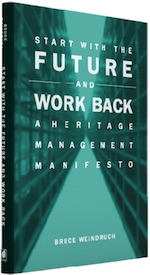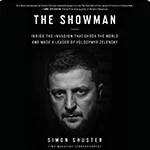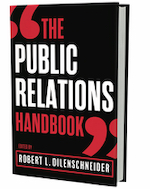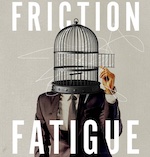|
|
Weinruch, who founded the The History Factory in 1979, has based his company around the idea of heritage management. He describes this philosophy as “the discipline that leverages and organizes its inventory of experience — its stories, its icons, its lessons learned — so that they can use those to address either the challenges or opportunities of growth.”
 Weindruch’s career has included stints advising top tier companies such as Goldman Sachs, Microsoft and Pfizer, often citing that a company need only look back to inspire advancement.
Weindruch’s career has included stints advising top tier companies such as Goldman Sachs, Microsoft and Pfizer, often citing that a company need only look back to inspire advancement.
The manifesto hones in on practical techniques that can be applied in the workplace on both micro and macro levels to increase consumer visibility and connect initiatives to a larger audience. With countless examples of industry successes, Weindruch uses these real-life cases while tracing how to use a company’s history to create a specific narrative to draw in the consumer. Readers might want to take note: with a large section of the country experiencing an economic downturn and the volatility of new media platforms, Weindruch’s suggestions offer solutions to cash strapped industries.
Weindruch highlights something that, while approaching common knowledge with its simplicity, could be a critical aspect of humanizing companies that can often be considered faceless.
“Heritage is a resource an organization already owns and its abundant — they don’t have to buy it, they don’t have to go out and get it, its already there.” And he isn’t wrong: while the idea of adding more humanistic traits to businesses as a way of gaining consumer sympathy isn’t exactly breaking news, he notes the advantage of using a company’s individual narrative and history to differentiate them from their peers. It highlights them as a unique entity with a visible identity and encourages brand loyalty. With the constant flux of new content and rapid business with new media expansion, this approach can lead to a competitive edge that, if successful, can help attain brand recognition in a sympathetic light.
Weindruch’s laymen style explanation of how to put this ideal into practice allows his words to be applicable to multiple industries at multiple levels. His advice is timely, honing in on the sort of cultural backlash that has been occurring in response to the unprecedented surge of consumer approaches through new media.
At the end of the day, elements of humanity and connections to them has been proven to sustain connection to the consumer, and it is this approach over others that Weindruch encourages in ‘Start with the Future and Work Back: A Heritage Management Manifesto.”
* * *
Caitlin Philippo is an Editorial Assistant at O’Dwyer’s.



 Time correspondent Simon Shuster’s “The Showman” demonstrates how Ukraine president Volodymyr Zelensky’s masterful knowledge of PR tactics and the power of propaganda transformed him from comedian into a respected world leader.
Time correspondent Simon Shuster’s “The Showman” demonstrates how Ukraine president Volodymyr Zelensky’s masterful knowledge of PR tactics and the power of propaganda transformed him from comedian into a respected world leader. Iuliia Mendel, who served as press secretary for Ukraine president Volodymyr Zelensky from 2019 to 2021, will release a book called “The Fight Of Our Lives” in September, published by Simon & Schuster’s One Signal Publishers.
Iuliia Mendel, who served as press secretary for Ukraine president Volodymyr Zelensky from 2019 to 2021, will release a book called “The Fight Of Our Lives” in September, published by Simon & Schuster’s One Signal Publishers. Robert Dilenschneider, former CEO of Hill and Knowlton, is releasing the fifth edition of The Public Relations Handbook on Feb. 15.
Robert Dilenschneider, former CEO of Hill and Knowlton, is releasing the fifth edition of The Public Relations Handbook on Feb. 15.  Big Advertising may be down for the count, but the power of marketing lives on. That’s the big takeaway from Paul Dyer’s “Friction Fatigue,” a look at what advertising’s downward spiral means for “future-focused brands."
Big Advertising may be down for the count, but the power of marketing lives on. That’s the big takeaway from Paul Dyer’s “Friction Fatigue,” a look at what advertising’s downward spiral means for “future-focused brands." Sabrina Horn, the high-tech PR guru who sold her Horn Group to Finn Partners in 2015, has published “Make It, Don’t Fake It.”
Sabrina Horn, the high-tech PR guru who sold her Horn Group to Finn Partners in 2015, has published “Make It, Don’t Fake It.”


 Have a comment? Send it to
Have a comment? Send it to 
No comments have been submitted for this story yet.